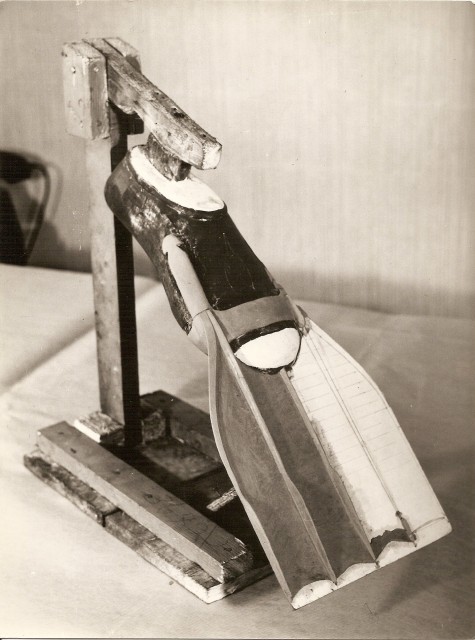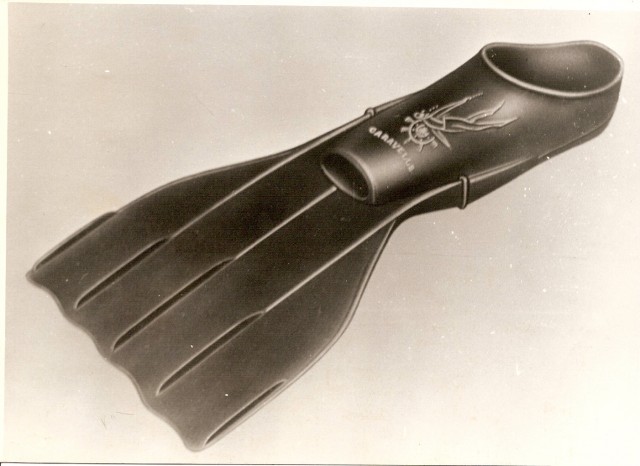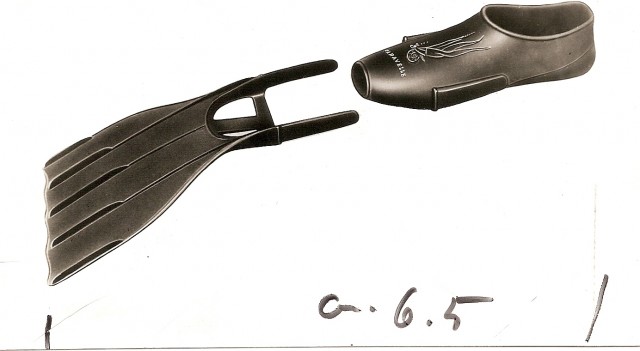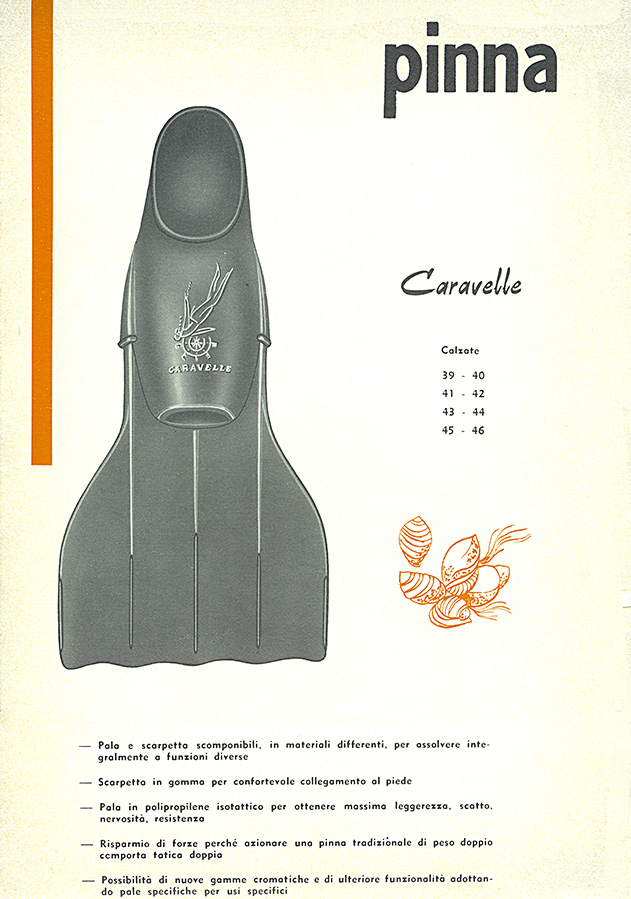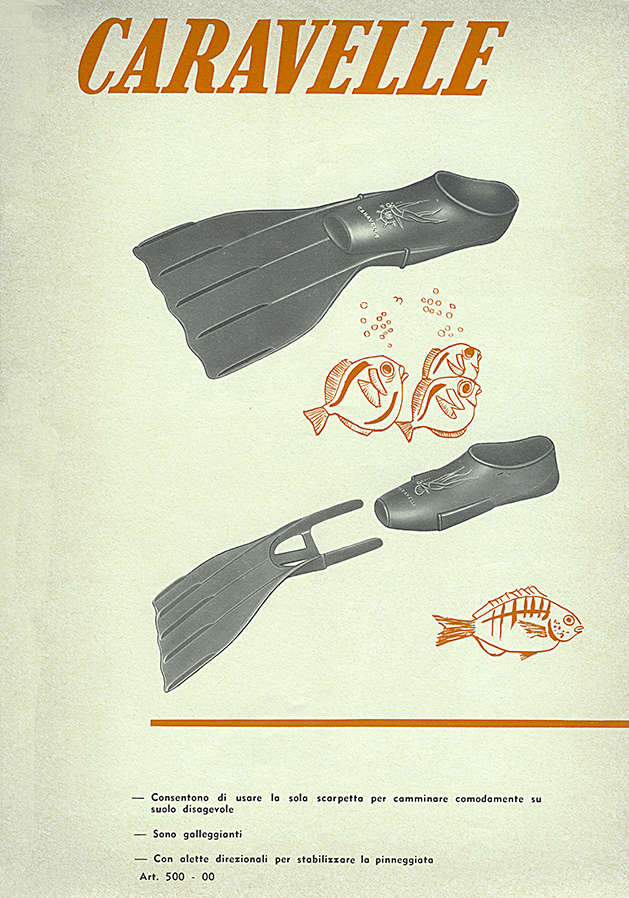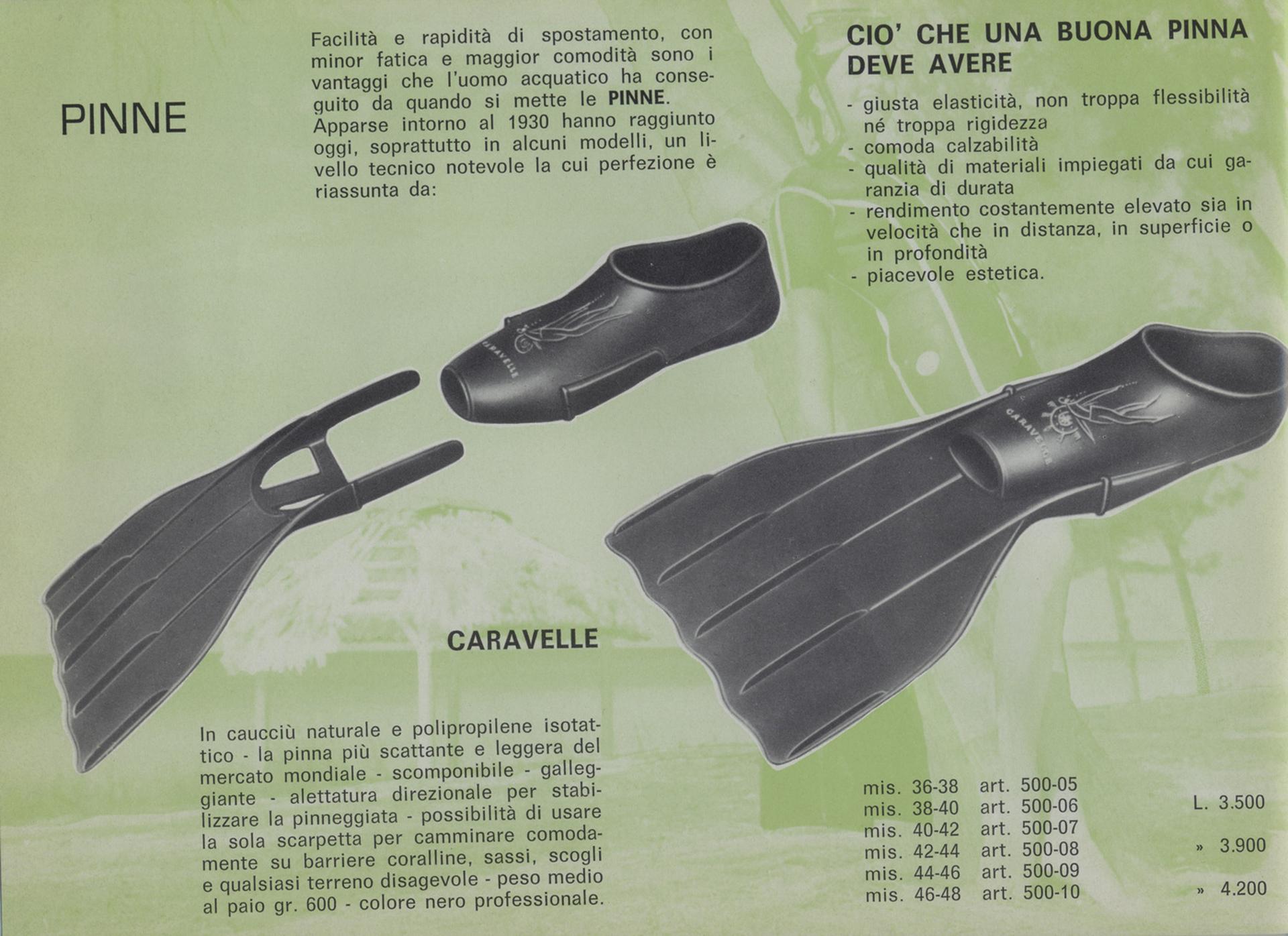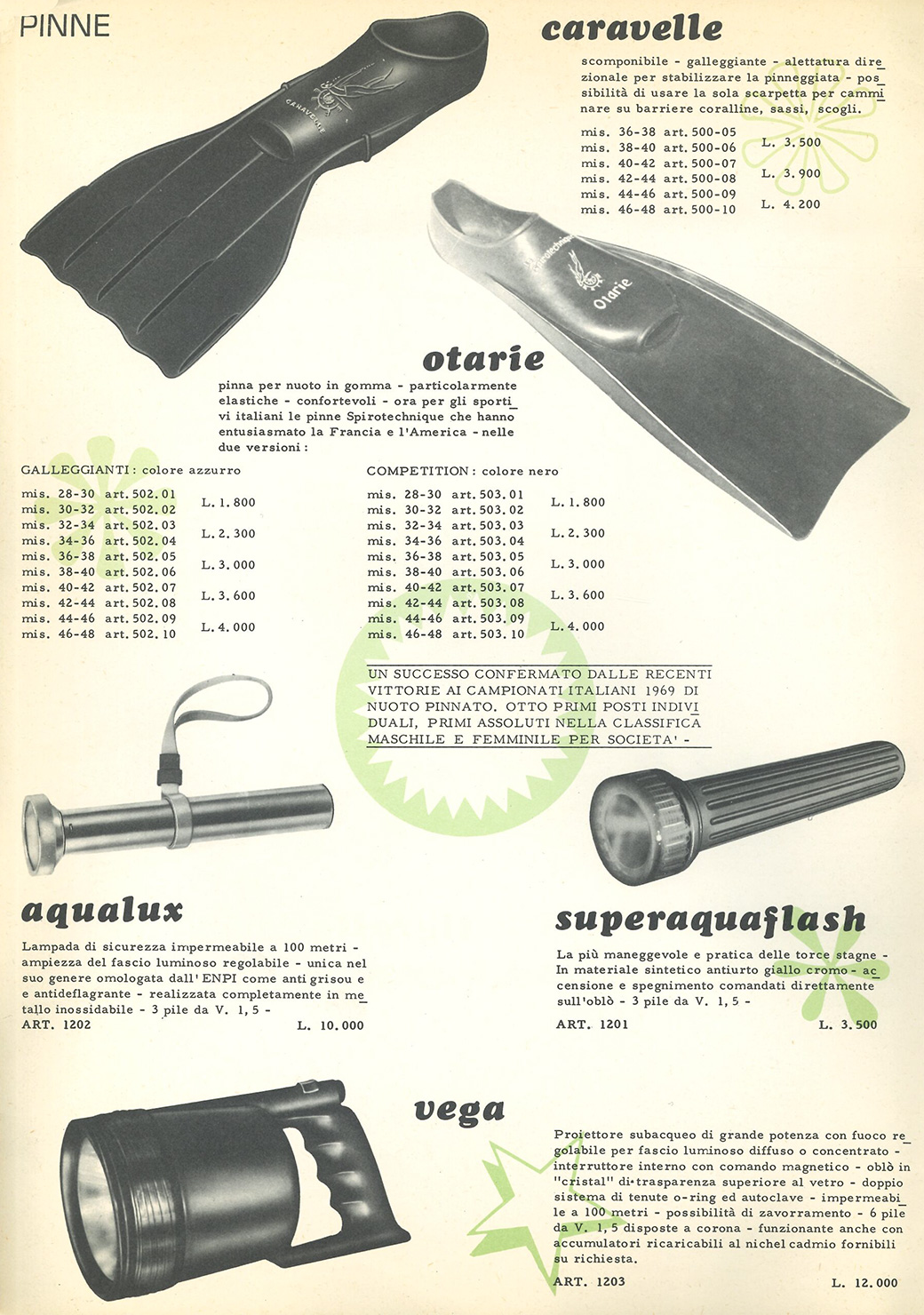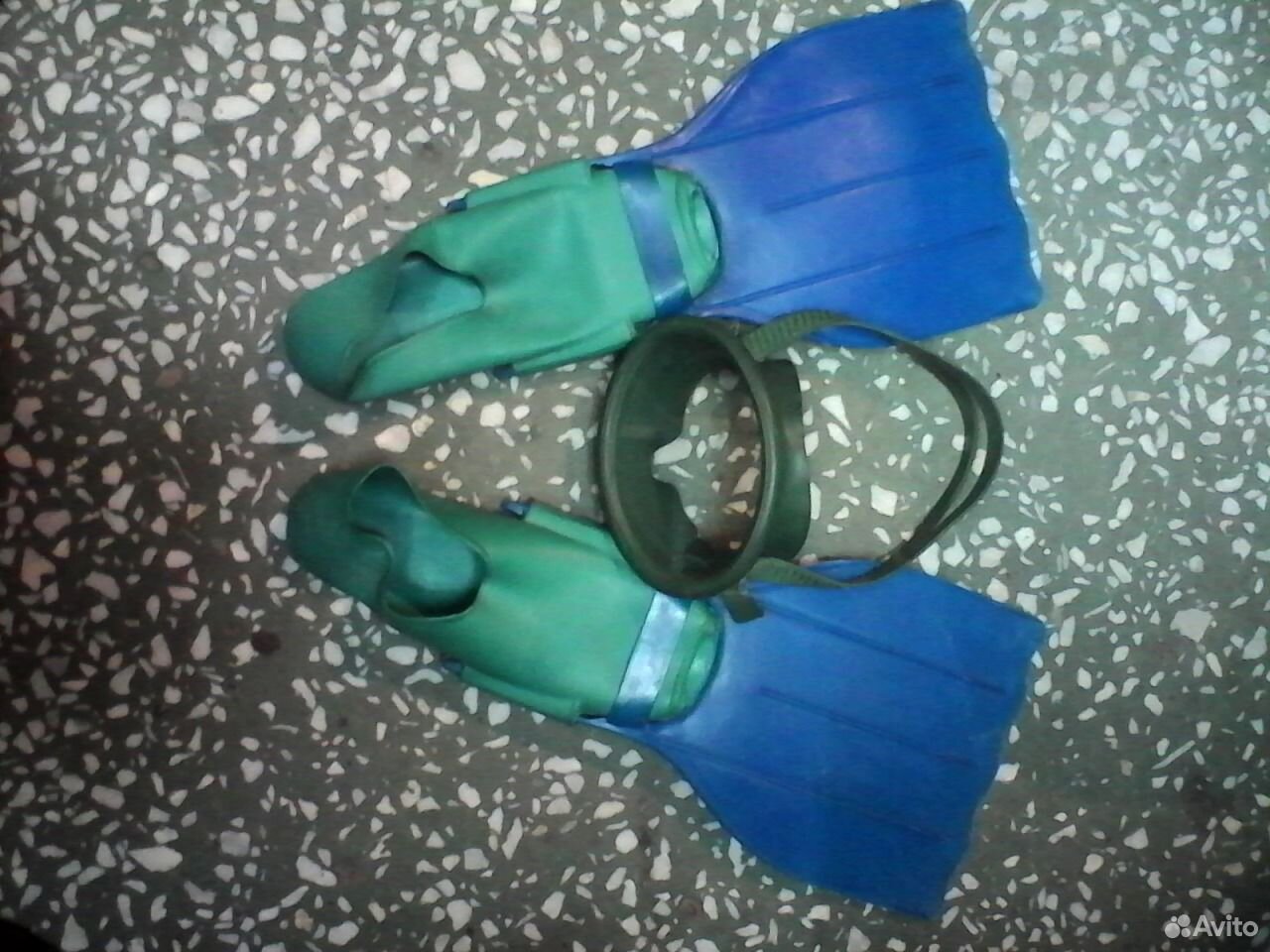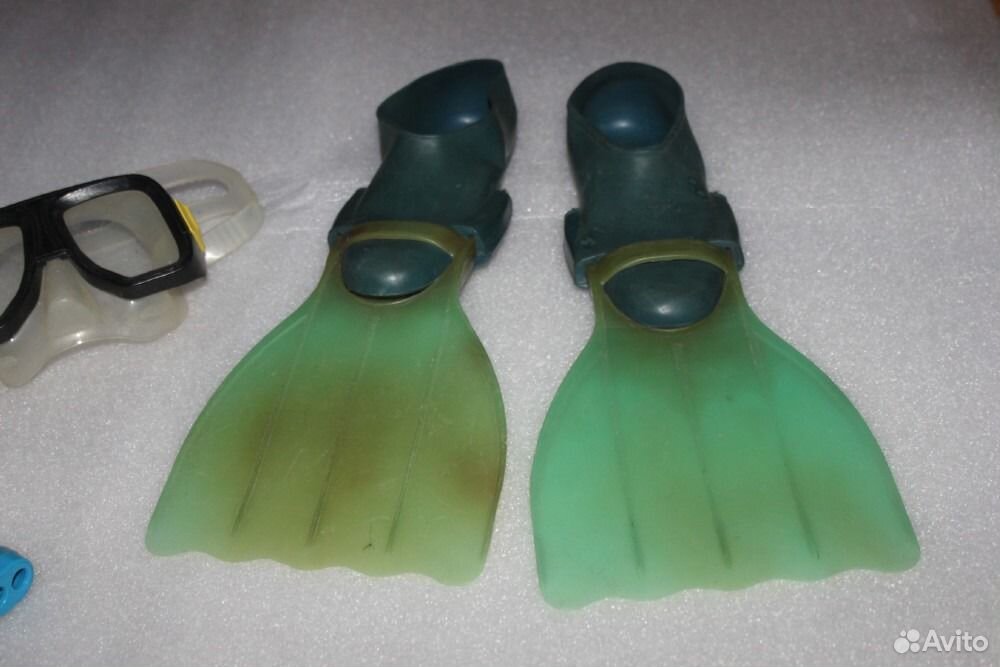In
1965, the Italian diving magazine published a piece on the Technisub Caravelle:
Italian: "Rivoluzione totale nella tecnica delle pinne con le CARAVELLE. LEGGEREZZA INCREDIBILE. UN PAIO PESA GR. 530! La pala e la scarpetta, costruite separatamente, consentono l'impiego dei materiali più adatti a ciascuna delle diverse funzioni. Pala in polipropilene isotattico. Scarpetta in gomma galleggiante a durezza variabile. Congiunzione tassativa tra pala e scarpetta a pinne indossate. Il montaggio si esegue con notevole facilità. UNA LINEA FUNZIONALE, UNA FORZA DI PROPULSIONE STRAORDINARIA, UNA CONFORTEVOLEZZA ECCEZIONALE. La concezione rivoluzionaria delle "CARAVELLE" elimina la parte negativa delle pinne tradizionali cioè quella zona larga al punto di congiunzione della pala con la scarpetta, che richiede sforzo muscolare improduttivo".
Rough translation: "Total revolution in fin technology with the CARAVELLE. INCREDIBLE LIGHTNESS. ONE PAIR WEIGHS 530 GR.! The blade and the foot pocket, built separately, allow the use of the most suitable materials for each of the different functions. Isotactic polypropylene blade. Floating rubber foot pocket with variable hardness. Mandatory conjunction between blade and foot pocket while wearing fins. Assembly is carried out with considerable ease. A FUNCTIONAL LINE, AN EXTRAORDINARY PROPULSION FORCE, EXCEPTIONAL COMFORT. The revolutionary conception of the "CARAVELLE" eliminates the negative part of traditional fins, i.e. the wide area at the point of junction of the blade with the foot pocket, which requires unproductive muscular effort".
Here is the Caravelle in the
1965 Technisub catalogue:
Italian: "— Pala e scarpetto scomponibili, in materiali differenti. per assolvere integralmente a funzioni diverse. — Scarpetta in gomma per confortevole collegomento al piede. — Pala in polipropilene isotattico per ottenere massima leggerezza, scotto, nervosità, resistenza. — Risparmio di forze perché azionare una pinna tradizionole di peso doppio comporta fatico doppio. — Possibilità di nuove gomme cromotiche e di ulteriore funzionalità adottondo pale specifiche per usi specifici. — Consentono di usare la sola scarpetto per comminare comodamente su suolo disagevole. — Sono galleggianti. — Con alette direzionali per stabilizzore la pinneggiata".
Rough translation: "— Removable blade and foot pocket, in different materials. to fully perform different functions. - Rubber foot pocket for comfortable connection to the foot. - Isotactic polypropylene shovel to obtain maximum lightness, burn, nervousness, resistance. - Energy savings because operating a traditional fin with double weight involves double the effort. - Possibility of new chromate rubbers and additional functionality by adopting specific blades for specific uses. - They allow you to use just the shoe to walk comfortably on uneven ground. - They float. - With directional fins to stabilise the kick".
1968
Italian: "Facilità e rapidità di spostamento, con minor fatica e maggior comodità sono i vantaggi che l'uomo acquatico ha conseguito da quando si mette le PINNE. Apparse intorno al 1930 hanno raggiunto oggi, soprattutto in alcuni modelli, un livello tecnico notevole la cui perfezione è riassunta da: CIO’ CHE UNA BUONA PINNA DEVE AVERE. - giusta elasticità, non troppa flessibilità né troppa rigidezza. - comoda calzabilità. - qualità di materiali impiegati da cui garanzia di durata. - rendimento costantemente elevato sia in velocità che in distanza, in superficie o in profondità. - piacevole estetica. CARAVELLE. In caucciù naturale e polipropilene isotattico - la pinna più scattante e leggera del mercato mondiale - scomponibile - galleggiante - alettatura direzionale per stabilizzare la pinneggiata - possibilità di usare la sola scarpetta per camminare comodamente su barriere coralline, sassi, scogli e qualsiasi terreno disagevole - peso medio al paio gr. 600 - colore nero professionale".
Rough translation: "Ease and speed of movement, with less effort and greater comfort are the advantages that the aquatic man has achieved since putting on FINS. Appearing around 1930, they have now reached, especially in some models, a remarkable technical level whose perfection is summed up by: WHAT A GOOD FIN MUST HAVE. - right elasticity, not too much flexibility nor too much stiffness. - comfortable fit. - quality of materials used from which guarantee of duration. - consistently high performance both in speed and in distance, on the surface or in depth. - pleasant appearance. In natural rubber and isotactic polypropylene - the lightest and most agile fin on the world market - separable - floating - directional fins to stabilise the kick - possibility to use only the foot pocket to walk comfortably on coral reefs, stones, rocks and any difficult terrain - weight average per pair gr. 600 - professional black colour".
1969
Italian: "caravelle - scomponibile - galleggiante - alettatura direzionale per stabilizzare la pinneggiata - possibilità di usare la sola scarpetta per camminare su barriere coralline, sassi, scogli".
Rough translation: "caravelle - separable - floating - directional fins to stabilize the kick - possibility of using just the shoe to walk on coral reefs, stones, rocks".
So the Caravelle appeared in Technisub catalogues from the early to the late 1960s, each time with a highly detailed product description to explain how the fin operated. The underlying rationale was that the fin was well before its time in terms of technology but was hardly a best seller in the market place because it was so different from other fins of the period. There were certainly plastic fins around at the time, but they tended to be cheap products designed for children who wanted bright coloured gear or for people who could not afford to buy proper rubber fins.




